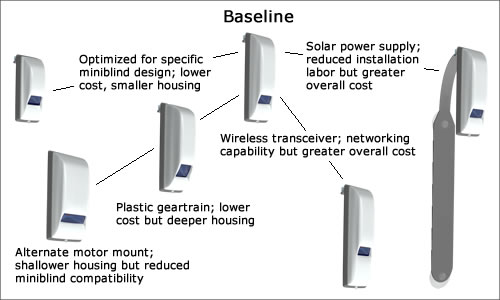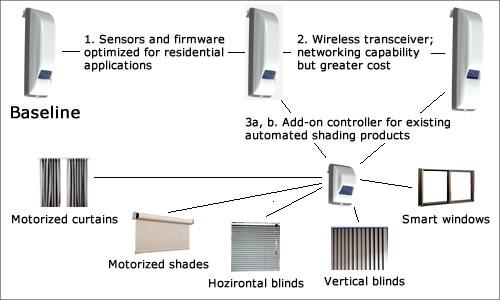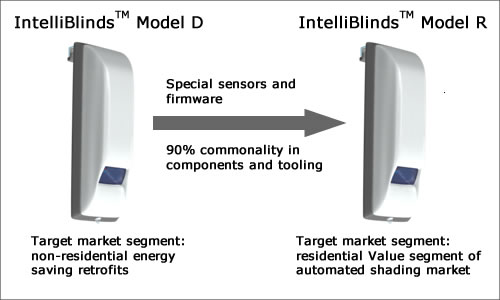Potential Design Trades
Design Trades for Target Market Segment
The target segment for the IntelliBlinds™ Model D is the market for energy efficient retrofits for non-residential buildings. The product attribute most highly correlated with market penetration in this segment is cost-effectiveness (i.e. the inverse of the payback period).
Accordingly, the IntelliBlinds™ Model D reference production design is aimed at minimizing the average projected payback period across the entire stock of U.S. non-residential buildings. This goal drove a number of design decisions, e.g.:
- The reference production design omits the Evo-3 prototype's wireless networking capability. This reduces IntelliBlinds™ direct costs as well as costs associated with the infrastructure necessary to take advantage of networking (e.g. software administration and support). Elimination of the need for networking is made possible by innovative sensor and algorithm technologies, which enable the IntelliBlinds™ Model D to operate fully autonomously.
- The IntelliBlinds™ reference design is specified to be compatible with 90% of the horizontal blinds currently installed in U.S. non-residential buildings. Achieving this broad compatibility increases the physical size of IntelliBlinds™, but also decreases its net average cost to the end-user.
- The IntelliBlinds™ reference design uses low-voltage DC power obtained from an AC wall transformer. This yields the lowest installed cost, but slightly compromises the asesthetics of the installation (due to the exposed wall transformer).
Of course, these and other decisions will be revisited before IntelliBlinds™ is produced in volume. The following chart lists some of the design trades being actively evaluated to maximize penetration in the target segment:

Design Trades for Other Market Segments
While the target segment is highly lucrative, it's just one of 24 distinct segments we've identified in the potential market for automated shading products—and the basic IntelliBlinds™ technology is just as advantageous for those other 23 segments as it is for the target segment. So, while our focus remains on non-residential daylighting retrofits, we continue to investigate dozens of design trades to leverage the technology for other markets. Some of those trades are illustrated in the following chart:

As shown in the previous chart (variants 3a and 3b), the IntelliBlinds™ sensor and control technology can be used in an add-on controller that boosts the functionality and ease-of-use of ordinary automated shading products, such as motorized window coverings or smart windows. Such a controller would provide the same automated shading intelligence as the most sophisticated building automation systems—but in an inexpensive, self-contained module that's easy to distribute and install. Our market research shows that the appeal and market penetration of conventional automated shading products can be substantially boosted by leveraging IntelliBlinds™ technology in this way.
However, the most lucrative alternative application for IntelliBlinds™ technology is variant 1 of the previous chart: with only minor changes to the sensors and firmware, the baseline IntelliBlinds™ design could achieve deep penetration of the residential market.
Residental Market Segmentation
The residential automated shading market is less interested in energy savings than the non-residential market, due in large part to the relatively low window-to-wall ratio and lighting power density in residential buildings.
Instead, the key automated shading benefits in the residential market are aesthetics, convenience, security, novelty, and prestige. Based on degree of interest in these benefits and demand elasticity with price, we've identified five distinct sub-segments in the residential automated shading market:
- Value segment
- Special Needs segment
- Gadget segment
- Luxury segment
- Mid-Tier segment
Of these, the largest potential segment—by far—is the value segment, with potential sales of over $1B per year. Yet this segment remains virtually untapped by existing automated shading products.
Penetrating the Value Segment
The primary product benefit in the Value segment of the residential automated shading market is convenience, and demand is extremely sensitive to a product's perceived price-to-convenience ratio.
In fact, the price-to-convenience ratio in the residential Value segment is analogous to the payback period in the non-residential energy efficiency segment. And many of the same innovations that make IntelliBlinds™ the first and only automated shading product that's cost-effective for non-residential daylighting are also directly applicable to the residential market. In fact, some of the innovations (e.g. IntelliTwist™ and IntelliState™) are even more advantgeous for the residential Value segment than for the non-residential daylighting segment.
Our conceptual IntelliBlinds™ Model R variant for the Value segment of the residential market shares more than 90% of the components and tooling with the baseline Model D daylighting configuration, but adds some breakthrough sensor and algorithm innovations that are the subject of in-process patent applications.

The IntelliBlinds™ Model R represents a completely new kind of residential automated shading product. It needs no complicated set-up or programming process, but instead actually learns—and then automatically delivers—the user's shading preferences. And because of its small size, ease of installation, and single-SKU compatibility with virtually every existing miniblind design, it's well-suited to retail as well as online and infomercial distribution. Finally, its cost is just a fraction of that of conventional automated shading products, enabling it to deliver a "convenience value" comparable to that of mainstream residential appliances.
Summary of Key Points
- The IntelliBlinds™ Model D reference design is aimed at minimizing the average payback period in non-residential retrofit daylighting applications, and therefore omits some capabilities and features supported by the underlying technology
- We continue to evaluate design trades for the target market segment, including revisiting the cost-saving decisions made for the reference design
- Most of the innovations that make IntelliBlinds™ so cost-effective for the retrofit daylighting segment are also advantageous for other applications and markets
- While our focus remains on the target segment, we're also evaluating potential design trades to best exploit the technology for 23 other market segments
- The most lucrative of these other segments is the Value segment of the residential automated shading market, with total potential volume exceeding $1B per year
- Only minor changes would be needed to the reference design to enable deep penetration of the residential Value segment

